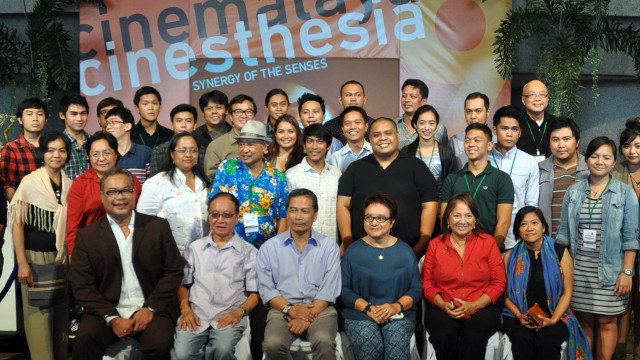SUMMARY
This is AI generated summarization, which may have errors. For context, always refer to the full article.

MANILA, Philippines – A film festival at the Cultural Center of the Philippines opens Friday, July 25, with a growing reputation for showcasing world-class movies focused on a diversity of social themes – including, this year, migrant labor and the seedy underworld.
From experimental, ultra-cheap films shown only to a handful of moviegoers when it began 9 years ago, Cinemalaya now attracts international distributors and its best offerings win rave reviews in the global festival circuit.
“We remain a small festival in Asia, but we have become a springboard for brave movies to be shown abroad,” Laurice Guillen, Cinemalaya Foundation vice president and competition director, told AFP.
Cinemalaya was launched to discover new, passionate filmmakers willing to push boundaries and create important works – providing alternatives to the usual feel-good Filipino and Hollywood films that dominate the box office.
“We show films that are based on real stories and that break new ground but done with a human heart,” said Guillen, herself an accomplished film director and actress.
But it wasn’t always easy.
Birth pains
The first batch of movies were shot and recorded on mini-DV (digital video), with audio quality far below that of big budget productions. Guillen remembers the entries being criticized as crude.
But with seed money from one of the Philippines’ most prominent businessmen and mentoring by seasoned directors, the quality improved steadily.
“Many recognized later that there was something brave and innovative going on,” Guillen said. “People came and watched because they wanted to [know] what the filmmakers were saying. They saw the heart and soul in the movies that were shown.”
Cinemalaya begins its work in the middle of each year, accepting as many as 200 applications for film grants from aspiring and established filmmakers across the archipelago.
A selection committee pares down the number to the best proposals from 15 directors, who are then called for interviews.
Once they pass that, the filmmakers are given the funds to begin their work, with Cinemalaya experts periodically reviewing the rushes and giving technical and creative advice.
For Guillen, the end products have been, for the most part, astounding, considering that each film cannot exceed the production cost of P3.5 million ($80,794).
READ: Cinemalaya: New breed of Filipino talent
Among this year’s much anticipated films is “Porno,” which, as director Adolfo Alix Jr. explained to AFP, depicts three lonely people seeking fulfillment in their empty lives through pornography.
Alix is one of the leading Filipino filmmakers today. “Porno” is his fifth entry in the festival-competition.
His film last year, “Kalayaan,” was a brooding tale about poorly armed soldiers coping with isolation in the Spratlys where they are stationed. The islands are being claimed by the Philippines and China, among other nations. The movie was honored Best Asian Film at the Warsaw Film Festival.
“Cinemalaya has been the right vehicle, allowing filmmakers like me to showcase our off-tangent subjects that may not be for commercial production,” Alix told AFP.
“I am a Cinemalaya product through and through, and the festival has helped directors like me to get our work out there.”
For first-time filmmaker Hannah Espia, 26, Cinemalaya will give her a chance this year to honor the millions of Filipino overseas workers whose remittances sustain the Philippine economy.
Her movie, “Transit,” tackles the plight of a Filipino single father working as a caregiver in Israel who seeks to avert his young son’s deportation.
“We always say OFWs (Filipino migrant workers) are our modern day heroes, but we really do not know their struggles,” she said.
Watch the trailer for ‘Transit’ here:
Both directors said they hoped their films would follow the success of “Bwakaw,” last year’s standout that tells the story of a grumpy old man coping with despair, amid his belated homosexuality, and finding companionship in a stray dog.
“Time” magazine hailed “Bwakaw” as one of its 10 must-see films when it made its way to the New York Film Festival last year.
The movie was subsequently entered as the Philippines’ entry to the Academy Awards, but it failed to make the final list of nominees.
Cinemalaya primarily serves as an entry point for relatively unknown actors and directors, but their mainstream counterparts have increasingly taken part in this festival through the years.
This year, it’s the iconic Vilma Santos taking part in Cinemalaya, in a deglamorized role as a bit actor in “Ekstra.”
Watch the trailer for ‘Ekstra’ here:
Nearly a decade into the Cinemalaya experiment, Guillen takes great satisfaction that more and more people are appreciating the festival, as it steps out of its traditional home at the CCP and into commercial cinemas.
“I always say that if you want to understand our culture, you need to watch our films,” Guillen said. – Rappler.com
Cinemalaya opens Friday, July 26, at the Cultural Center of the Philippines. The festival begins with Baby Ruth Villarama’s gay-themed documentary, “Jazz in Love.” The event is open to the public. For more information, you may contact the CCP at 832-1125, local numbers 1113, 1115, 1116, and 1117, or click www.cinemalaya.org.
Add a comment
How does this make you feel?
There are no comments yet. Add your comment to start the conversation.